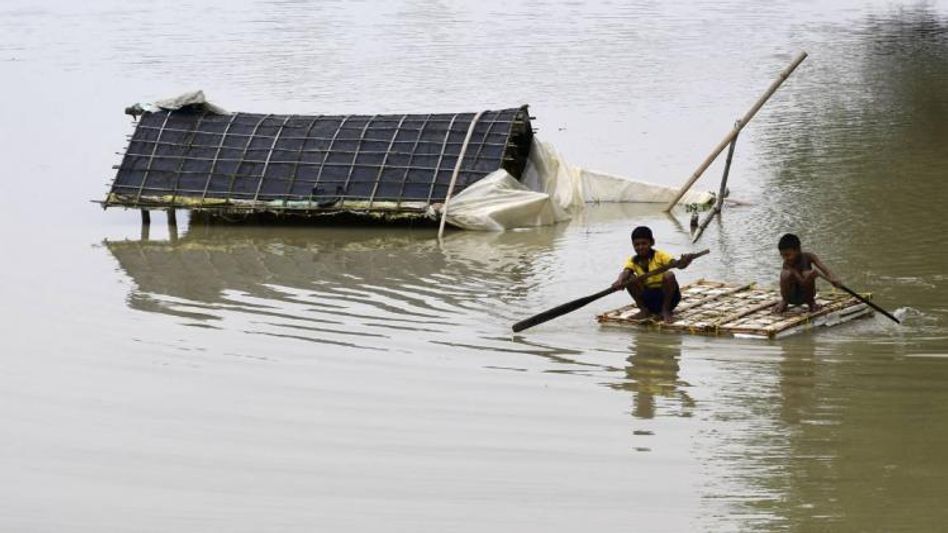How technology can help avert natural disasters in North East
Assam and a few northeastern states have been witnessing regular disasters over the years and this year the impact has been severe with heavy rains bringing in disruption and destruction.
 Natural disasters in North East
Natural disasters in North EastOn 29 June this year, in the 77th meeting of the Brahmaputra Board, it was decided to carry out a 2 phase study of the Barak basin that falls in 11 districts of the northeastern region in the states of Assam, Manipur, Nagaland, Mizoram and Meghalaya and make recommendations. The first study would be undertaken by the North Eastern Space Applications Centre (NESAC) for 3-4 months and then in the second phase, a committee under the chairmanship of a Member of the Brahmaputra Board comprising members of various organisations of the union government and the 6 states as mentioned above would examine the NESAC report and advise on sustainable solutions to the problems of the Barak basin. Meanwhile, a pilot project in the same basin is being undertaken currently by the National Institute of Technology Silchar.
Assam and a few northeastern states have been witnessing regular disasters over the years and this year the impact has been severe with heavy rains bringing in disruption and destruction. It has impacted the hills with landslides and slush movements while rampant floods across urban and rural areas is impacting work and movement. These rains and the resulting disasters have brought to the fore the need to find means to address them from the perspectives of early warning and disaster management. The good news is that today a combination of cutting-edge technology and innovative practices can help in addressing the issues with the help of predictive analysis and then managing disaster management and rehabilitation with the help of optimal tools.
In this context, it will be pertinent to touch upon two areas that the state needs to focus on where today’s emerging technologies can make a difference. These two areas have also been mentioned ever since independence- Flood management and agriculture productivity optimisation including the tea industry. Both these areas need a focused long-term approach and the effort has to start now. With technology like high-performance computing (HPC), artificial intelligence (AI) and machine learning (ML) available today and deployed successfully elsewhere, these can be applied to optimise these sectors. The availability of space technology and its application in the northeast region like the mapping of forest gap areas, expansion of the land area for horticulture development, identification and rejuvenation of wetlands and diversion of floodwater have already been embarked upon by the NESAC at Shillong. On top of this, the union government is very supportive to address the perennial issues of the northeast and also looking at economic development. The NIT pilot and NESAC study are indicators of a good start and orientation towards technology.
Both the Brahmaputra and Barak rivers in Assam have been responsible for inundating the valleys and basin annually causing devastating floods resulting in enormous economic loss and fatalities, both human and livestock. Erosion is a major problem and the state has lost 8% of its land mass since independence due to the phenomenon. The recent disaster in Dima Hasao district where the railway and road networks have been washed away from various locations and also houses were destroyed by landslides, has shown that hills have also become very vulnerable.
The government has to move away from the only flood management approach so far to a flood prediction focus based on the available data from NESAC. This can help the government acquire actionable intelligence in advance that will help in crafting appropriate response strategies which could range from evacuating the predicted area of impact to sandbagging to arranging for rations for the displaced population. A flood forecasting system commonly consists of a numerical weather prediction model to provide rainfall forecasts and a hydrological/hydraulic model to predict the hydrological response. Whilst being widely used for flood forecasting, hydrological models only provide a simplified representation of the physical processes of flooding and cannot reliably predict the highly transient flooding process from intense rainfall, in which case a fully 2D hydrodynamic model is required. HPC and AI which mimics the brain's process can carry out parallel computations with massive amounts of data that can effectively map the approximate model of the flooding with almost 36 hours of lead time, enough to mount a credible response. Some of the recent cyclone warnings have worked on HPC and thus a lot of coastal people could be shifted and deaths averted.
Agriculture and allied industries support the majority of the population in the state. Unfortunately, the agro sector is characterised by low farm sizes, low financial return on crops and unscientific farming techniques. On the plus side, Assam has some of the most fertile lands in the country and waterway access to reach global markets. A radical rethink is required to resurrect the fates of the farming population. Here, one could even exploit the psychological impact of the pandemic that is fuelling a move towards healthier foods. Cash crops like millets for instance, have been connected with better health and are in huge demand in the rest of the country as well as the Middle East and Europe. The government could encourage setting up a processing and packing plant and contractually engaging the agricultural community to grow millets and fruits. The process would add value across the supply chain using AI and ML and create greater prosperity for the farmers towards the realisation of athmanirbharta.
Again HPC can help here in optimising agricultural activity, plague control, pesticide design and pesticide effects. With the help of NESAC, a proper assessment of the land availability and its suitability can be undertaken and then HPC enabled numerical simulations of plant growth that can help farmers, as well as seed companies, achieve superior varieties, without doing costly field trials that can harm the environment. Assam can benefit tremendously through simulation models that could help grow better millets and tea through data-driven insights of the simulation models. Israel has already used these technologies to make the best of their available land to foster quality agricultural produce and has already engaged with Assam and other state governments to help in this sector. A properly planned approach can help the government to have distributed farming of different crops depending on the soil conditions and climate and market linkages can be done using the e-commerce route as also optimised distribution model.
In the last year, Assam's chief minister has also pushed his ministers and officers to pace up and try and run as he sprints across sectors with a hands-on approach. Many of the chief ministers in other northeastern states are also looking at bringing in technology and optimal methods to solve existing problems in their states. This gives confidence that long-term issues that afflict the state will be sincerely addressed this time as also near-term actions like creating gainful employment for youths in the form of shared prosperity rather than pushing them to the government jobs chase mindset. Needless to say, technology will be the biggest facilitator in most of these efforts.
Copyright©2025 Living Media India Limited. For reprint rights: Syndications Today









